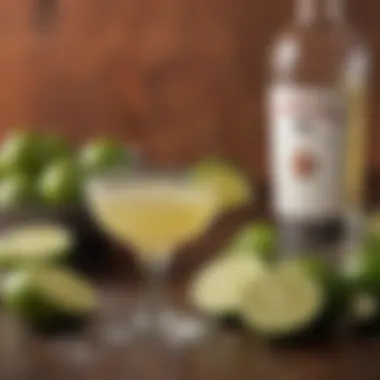Margarita: An Intricate Exploration of a Classic Beverage


Intro
The margarita, often celebrated as a quintessential cocktail, offers far more than a refreshing sip on a hot day. This beverage weaves a narrative through history, cultures, and social gatherings, morphing into a symbol of relaxation and celebration. As we unpack its layers, we will explore its origins, the evolution of its ingredients, and how numerous regional variations have shaped its identity.
By delving into the beverage's trajectory from its historical roots to modern adaptations, we uncover its relevance today. Whether it is the classic lime margarita or more inventive versions, this exploration uncovers a broad spectrum of flavors, techniques, and cultural significance. From ingredient selection to presentation, each detail can elevate a margarita from a simple drink to an experience.
We will also examine how dietary trends influence the way we craft this beloved beverage. Flavors can be tailored, and unique pairings with food enhance every sip and stimulate conversation. As we go deeper, valuable insights will guide readers seeking both the optimal recipe and the secrets behind creating that perfect margarita.
Let us embark on this in-depth journey into the art of margarita-making, reflecting its rich history and playful modern interpretations.
Historical Context of the Margarita
The margarita is more than just a popular cocktail enjoyed across the globe. It represents a convergence of culture, history, and social interaction. Understanding its historical context provides valuable insight into its significance and evolution through time. The margarita traces its roots through various theories that attempt to pinpoint its exact origin. Furthermore, its cultural significance has grown, reflecting societal shifts and culinary trends.
Origin Theories
The origins of the margarita are surrounded by various theories that pinpoint its beginning in the early to mid-20th century. One prevalent belief is that it was first created in the 1930s by a bartender named Carlos "Danny" Herrera at his Tijuana bar. The story goes that he crafted the drink for actress Rita Hayworth. Another theory links the margarita to a similar drink known as the „Daisy,” popularized in the United States. The difference lies in the use of tequila instead of the traditional spirits used in the Daisy cocktails.
Additionally, some claim its roots are tied to the Mexican tradition of serving tequila with lime and salt, a practice that goes back centuries. These theories not only showcase the possible origins of the margarita but also highlight its evolution as a beverage reflective of both Mexican heritage and American drinking culture.
Cultural Significance
The cultural significance of the margarita extends beyond its enjoyable taste. It has become a symbol of celebration and relaxation, often associated with lively gatherings. The drink’s availability in various forms, from frozen to on the rocks, has made it adaptable to multiple settings, from casual family barbecues to elaborate dining experiences.
In Mexican culture, the margarita is often enjoyed during traditional festivities. It is a staple at events like Cinco de Mayo, where it embodies happiness and communal spirit. American culture has embraced the margarita as well, making it a common feature in bars and restaurants, indicative of a casual yet festive atmosphere.
While the margarita has evolved, its roots remind us of the importance of traditions and the way a simple drink can bridge cultures, showcasing shared experiences through flavours. The margarita is not just a beverage; it reflects a dual heritage, celebrating both Mexican origins and American adaptations.
The Anatomy of a Margarita
Understanding the anatomy of a margarita is essential for anyone looking to appreciate this iconic beverage fully. Each component plays a pivotal role in creating the experience that margaritas offer. From the main ingredients to the mixing techniques, every aspect contributes to the overall flavor and presentation. This section will detail these elements, exploring the importance of key ingredients, the variety of tequila, and the selection of citrus.
Key Ingredients
The foundation of a margarita rests on its key ingredients: tequila, lime juice, and orange liqueur.
- Tequila: This is the spirit that defines the margarita. The quality and type of tequila directly influence the drink's flavor. Tequila is primarily made from the blue agave plant and its variations include blanco, reposado, and añejo, each offering distinct taste profiles.
- Lime juice: Freshly squeezed lime juice is crucial. It provides the sharp, tangy character that balances the sweetness of the orange liqueur and the tequila. The acidity of the lime juice brightens the overall taste of the drink.
- Orange liqueur: Common choices such as Cointreau or Triple Sec add sweetness and depth. The precise amount used can shift the balance of flavors, making this ingredient vital for achieving the right taste.
In crafting a margarita, these ingredients must be in harmony, combining to create a well-rounded cocktail.
Types of Tequila
When selecting tequila, understanding the different types can assist greatly in enhancing the margarita's flavor. There are several categories, each with its distinct profile:
- Blanco: Often unaged; it offers a vibrant flavor of agave with a crisp finish.
- Reposado: Aged in oak barrels for up to a year; it brings a smoothness and added complexity from the wood.
- Añejo: Aged for over a year, this type has a rich, deep flavor and a softer finish.
- Extra Añejo: Aged for at least three years; it provides luxurious notes and a very smooth texture.
Choosing the right type of tequila is essential as it impacts the drink’s overall character significantly.
Choosing the Right Citrus
Selecting the best citrus is a fundamental step in crafting an exquisite margarita. While lime is the classic choice, other fruits can give unique twists.
- Lime: The quintessential citrus for margaritas, it offers bright, zesty flavor.
- Grapefruit: This can add a delightful bitterness, offering a refreshing alternative.
- Lemon: This fruit can create a lighter, more citrus-forward margarita.
While lime remains a staple, experimenting with various citrus options can yield creative and interesting results, appealing to diverse palates.
"The margarita's flavor comes from a careful balance of tequila, citrus, and liqueur. Each ingredient must serve its purpose."


Understanding these elements of the margarita enables enthusiasts to appreciate each sip. This insight can transform the cocktail experience and foster a deeper connection to this beloved beverage.
Contemporary Variations
Contemporary variations of the margarita reflect evolving tastes and cultural shifts within the culinary landscape. Understanding these changes allows both drinkers and makers to embrace the creativity that transforms a classic beverage into a modern favorite. This section explores the diverse adaptations found in regional drinking cultures, the infusion of fruits, and low-calorie options that cater to health-conscious consumers.
Regional Twists
Different regions have their own spin on the margarita, which enhances its appeal across cultures. In Mexico, the classic blend of tequila, lime juice, and orange liqueur often meets local flavors. For example, in Oaxaca, mezcal is more common than tequila, offering a smokier profile that is distinct. Variations also arise from the local availability of produce, leading to unique ingredients such as tropical fruits in coastal areas.
- Tamarind Margarita: Enhances the drink with a tangy depth.
- Pineapple Margarita: Incorporates juicy and sweet notes, popular in beach settings.
- Mango Margarita: Often blended, providing a creamy texture.
These regional adaptations not only delight the palate but also serve as a reflection of the local culture. They showcase how a single beverage adapts and changes based on ingredients available and the traditions that surround it.
Fruit-Infused Margaritas
Fruit-infused margaritas are gaining popularity for their versatility and the fresh flavors they bring. By incorporating fruits into the mix, bartenders can create vibrant, flavorful alternatives to the traditional margarita. Some commonly used fruits include:
- Strawberries: Provide sweetness and a bright color.
- Watermelon: Adds a refreshing quality perfect for summer.
- Raspberries: Introduce a tart element, balancing the sweetness of the liqueurs.
To achieve these flavors, fruits can be muddled, pureed, or even infused into the tequila prior to mixing. This method allows for an array of choices, each offering a unique drinking experience. The infusion process engages both taste and visual appeal, making these drinks not just beverages but an experience in color and flavor.
Low-Calorie Options
With the rise of health-consciousness among consumers, low-calorie margarita options have emerged. These adaptations cater to those who wish to enjoy the cocktail without compromising on dietary goals. Low-calorie margaritas can be crafted using alternatives such as:
- Agave Nectar: A natural sweetener that maintains a lower calorie count compared to sugar.
- Fresh Lime Juice: Using juice instead of sugary mixers helps control caloric intake.
- Soda Water: As a substitute for sugary sodas or syrups, it keeps the drink refreshing without the extra calories.
End
Contemporary variations of the margarita showcase how this traditional drink continues to thrive. By exploring regional twists, indulging in fruit-infusions, and considering low-calorie options, consumers and creators alike can participate in the evolution of this classic beverage. These adaptations not only meet the tastes of modern drinkers but also invite creativity and adaptation in the world of cocktails.
Ultimately, understanding these variations allows one to appreciate the margarita not just as a drink, but as a canvas for flavor and tradition.
Crafting the Perfect Margarita
Crafting the perfect margarita is not just a matter of mixing a few ingredients together. It requires a nuanced understanding of flavors, techniques, and tools to create a drink that meets both taste and aesthetic expectations. This section will cover essential tools, effective mixing techniques, and the vital balance that ensures a delightful experience with each sip.
Essential Tools
To begin, having the right tools is crucial for preparing an exceptional margarita. Some may consider this an unnecessary expense, but the investment pays off in the quality of the margarita produced. Below are the essential tools:
- Cocktail shaker: A good quality shaker helps in mixing ingredients thoroughly. It ensures proper aeration, enhancing flavor.
- Jigger: For accurate measurements, a jigger is invaluable. It allows for precise control over the amount of tequila and other ingredients, avoiding dilution or overpowering flavors.
- Strainer: Essential for serving, a strainer keeps unwanted ice and solids out of the finished cocktail.
- Muddler: Useful for extracting flavors from herbs or fruits, a muddler adds depth to the margarita.
- Citrus juicer: Fresh juice is necessary for any margarita. A quality juicer simplifies extracting juice from limes or other citrus.
Mixing Techniques
Next, the way the margarita is mixed can greatly affect its flavor and presentation. Different techniques yield different results. Here are some recommended methods:
- Shaking: This is the most popular method. Combine the ingredients in the shaker with ice and shake vigorously. This technique fully integrates the flavors, resulting in a refreshing drink.
- Stirring: For a more delicate cocktail, stirring is preferred. This method is often used for cocktails without citrus, allowing for a more controlled mixing process.
- Blending: Popular for frozen margaritas, blending combines ice, tequila, lime, and any additional flavors into a smooth, slushy drink. Ensure the blending is done just until ice is crushed, to maintain texture.
When mixing, consider the order of ingredients. Always add ice after combining liquid for shaking. This ensures the ingredients become chilled without excessive dilution.
Striving for Balance
Achieving balance in a margarita is essential. Successful margaritas maintain flavor harmony among their ingredients. Here are key points to strive for:
- Acidity: The tartness of citrus is fundamental. Use fresh lime juice for brightness. Adjust levels to taste, but do not overpower the drink.
- Sweetness: A correct amount of sweetener, such as simple syrup or agave nectar, can offset acidity. Start with small quantities and adjust per preference, maintaining the drink's overall appeal.
- Strength: The right tequila is essential. Depending on your taste, adjust the tequila's strength to match the other flavors. The ratio of tequila, lime, and sweetener should ideally remain balanced, often falling within a 2:1:1 ratio.


In summary, crafting the perfect margarita requires not just skill, but also the right tools and a clear understanding of how to mix different flavors harmoniously. A well-crafted margarita is reflective of its creator's attention to detail, and it plays a significant role in the enjoyment of this celebrated beverage.
"The best margaritas are not just about quality ingredients; they reflect a careful balance, where every component has a voice."
These principles guide the margarita enthusiast toward a satisfying creation that can be uniquely appreciated.
Flavor Pairings with Margaritas
Understanding the right flavor pairings with margaritas elevates the overall experience of enjoying this cocktail. The synergy between food and drink often enhances palatability and makes for a richer dining experience. Margaritas, with their vibrant acidity and distinctive sweetness, can complement a variety of flavors, making thoughtful pairings necessary. This section will explore appetizers, main courses, and desserts that harmonize with the components of a classic margarita, providing epicurean depth to your culinary journey.
Appetizers
When choosing appetizers to accompany a margarita, focus on flavors that echo the beverage's citrus notes and herbal elements. Dishes that incorporate zest and freshness work exceptionally well. Consider options like guacamole and salsa with corn tortilla chips; their richness pairs beautifully with the margarita's refreshing qualities.
Other suitable choices include shrimp ceviche, where the bright lime flavors mirror the cocktail. Spicy jalapeño poppers can also be a hit, offering a contrast to the coolness of the drink while enhancing its character. A few other good selections are:
- Fish tacos: Light and well-seasoned, they capture the spirit of coastal cuisine.
- Quesadillas with cheese and peppers: Simple but flavorful, providing texture that balances the margarita's liquid form.
Main Courses
For main courses, the pairing should maintain a balance between flavor complexity and intensity. Grilled chicken or fish, seasoned with herbs and spices, aligns perfectly with the crisp and bright acidity of a margarita. Beef tacos, especially those prepared with a citrus-forward marinade, bring an engaging contrast of flavors.
Vegetable-based dishes can also be successful. For example, a mixed vegetable fajita allows the drink's citrus notes to brighten the earthy flavors of the vegetables. Here are some other options worth considering:
- Chili con carne: Highlights richness that makes the margarita's freshness pop.
- Seafood paella: The dish’s fragrant saffron and fresh seafood meld well with the cocktail.
Desserts
Margaritas can also be paired with desserts, offering an unexpected delight for the palate. Desserts that carry citrus notes tend to be the most effective at achieving harmony with the drink. Consider options like key lime pie, where the tartness complements the beverage's profile beautifully.
Fruit salads, especially those featuring tropical fruits like mango or pineapple, can enhance the margarita's refreshing aspect. A few sweet choices include:
- Flan: Its creamy texture contrasts nicely with the margarita.
- Chocolate lava cake: The richness of the chocolate can surprisingly blend well with the cocktail if balanced correctly.
Pairing margaritas with food is not just about compatibility. It’s about creating a cohesive experience that pleases all senses, where each component enhances the other.
In summary, recognizing how the flavors of margaritas can interact with various dishes allows you to create thoughtful pairings. Whether highlighting fresh ingredients in appetizers, balancing flavor in main courses, or surprising with dessert, each choice can contribute to a more profound enjoyment of this classic drink.
Presentation and Garnishing
Presentation and garnishing are essential elements when it comes to serving a margarita. They influence the drink's visual appeal, enhance the drinking experience, and contribute to the overall enjoyment. When one thinks about a margarita, the first impression often comes from how it is presented. This experience can affect not only the perception of taste but also the ambiance of a social setting.
Choosing the right glass not only serves a functional purpose but also plays a significant role in aesthetics. The appearance of the glass can complement the vibrant colors of the margarita, inviting guests to indulge. Furthermore, tasteful garnishing can elevate a simple cocktail into something that feels gourmet. Carefully selecting elements that align with specific flavors can lead to an enhanced drinking experience and provoke conversation among guests.
Glassware Selection
The glassware used for serving margaritas serves as more than just a container. Popular choices include the traditional margarita glass, often characterized by its wide rim and shallow bowl. This design allows for ample surface area, making the drink visually striking. However, some modern interpretations might opt for a coupe glass or even a rocks glass, each impacting the experience distinctly.
When selecting glassware, consider the following factors:
- Style: The glass should match the occasion. A casual gathering may suit a more laid-back style, while a formal event might benefit from elegant glassware.
- Functionality: Ensure that the glass is functional for the drink type. A glass with an appropriate size prevents spillage while highlighting the drink's presentation.
- Quality: Choosing high-quality glassware can enhance the experience, as it influences how the drink feels in hand and interacts with light.
Ultimately, glassware should enhance both the visual and tactile experience of the margarita.
Garnish Options
Garnishing a margarita can play a crucial role in enhancing not only the look but also the flavors of the drink. Simple yet thoughtful garnishes can raise the overall perceived quality. Popular options include:


- Lime Wedge: A classic choice, offering a vibrant touch and hinting at the cocktail's citrus notes.
- Salt Rim: Adding a salt rim alters the taste experience, providing a contrast that can heighten the drink’s flavors.
- Herbs: Fresh herbs, such as mint or basil, can provide a refreshing aroma and additional complexity.
- Fruits: Slices of fruits like jalapeño or strawberries can make a drink visually attractive while infusing slightly varied flavors.
The right garnish not only beautifies the drink but can also enhance the overall flavor and olfactory experience.
As the garnishing and presentation create an inviting aura, they engage guests visually and stimulate their taste buds, making them an integral part of the margarita experience.
Margarita in Popular Culture
The margarita, a cocktail often associated with relaxation and social gatherings, has a special place in popular culture. This significance goes beyond the drink itself. It often surfaces in literature, film, and social environments, acting as a symbol of leisure and conviviality. Its presence in these arenas speaks volumes about its cultural impact and the way it resonates with people across various demographics.
Margaritas in Film and Literature
Movies and books have long used the margarita to evoke feelings of escapism and warmth. In several films, characters sip margaritas while enjoying sun-soaked beach settings. This representation builds a narrative around the idea of celebration and carefree moments.
A notable example can be seen in the film "The Big Lebowski" where margaritas serve as a background to a laid-back lifestyle. The cocktail is not only consumed but is part of the dialogue, cementing its status within the bustling cultural canon. It invites viewers to imagine their own experiences tied to the drink, often inspiring them to recreate similar settings in their lives.
In literature, margaritas can convey complex emotions. They might symbolize a moment of reflection or a joyous gathering. Authors often leverage this beloved cocktail to emphasize themes of friendship, leisure, and the pursuit of happiness. The images conjured can linger long after the page is turned, reinforcing the margarita’s status as a cultural icon.
Social Settings and Traditions
Margaritas are more than just a refreshing drink; they represent social connections. In various traditions, they are served during celebrations such as birthdays, holidays, and weddings. Their vibrant flavors and festive presentation make them an ideal choice for enhancing gatherings.
In many regions, there are specific customs around drinking margaritas. For instance, in Texas, margarita parties with music and food are common at summer barbecues. Special variations are often created for these occasions, incorporating local flavors and ingredients, reflecting the community’s identity.
Additionally, margaritas are integral to Mexican festivities, such as Cinco de Mayo. Here, they become symbols of cultural pride and community unity. Specific rituals and serving styles often accompany these gatherings, further enriching the experience.
By exploring margaritas in popular culture, we see how they embody more than just taste; they reflect social bonds and cultural significance that enrich our everyday lives.
Overall, the margarita's portrayal in films and literature, along with its role in various social settings, highlights its status as a beloved beverage. This cocktail transcends its simple ingredients, proving to be a cultural artifact that fosters connection and celebration.
Health Considerations of Margaritas
Understanding health considerations associated with margaritas is essential for informed enjoyment of this popular cocktail. Although margaritas can be a delightful addition to social occasions, they come with certain health implications that consumers should consider carefully. By examining alcohol content and dietary restrictions, individuals can better navigate their choices regarding this classic drink.
Alcohol Content and Moderation
The most striking aspect of margaritas is their alcoholic content, primarily derived from tequila. Most margaritas contain around 1.5 ounces of tequila per serving, which equates to approximately 1.5 standard drinks. Being aware of this can help individuals monitor their consumption and avoid excessive drinking, which can lead to not only impaired judgment but also various health issues.
Moderation is key. The Centers for Disease Control and Prevention defines moderate drinking as up to one drink per day for women and up to two drinks for men. Ultimately, it's important to balance margarita enjoyment with sober recovery time. Feeling aware of how many drinks one has consumed helps to maintain both physical well-being and social decorum.
Potential Dietary Restrictions
Margaritas can sometimes pose challenges for individuals with specific dietary restrictions. Classic margaritas primarily consist of tequila, lime juice, and possibly orange liqueur. While these ingredients are generally gluten-free, variations and additional ingredients may not be. Individuals with gluten intolerance or celiac disease should be vigilant when selecting margaritas.
Moreover, some margaritas include added sugars or syrups, which can be a consideration for those managing their sugar intake. Excessive sugar can contribute to health complications such as diabetes and obesity. For health-conscious consumers, opting for a margarita with fresh lime juice and minimal additional sweeteners might be a more prudent choice.
Thus, it is always useful to inquire about the ingredients in a margarita to avoid any unwanted surprises. Choosing organic or natural components when possible may also cater to those with conscientious eating habits.
It's essential to be mindful of both alcohol content and potential dietary restrictions when enjoying margaritas to ensure a pleasurable yet responsible experience.
Finale and Final Thoughts
In discussing the margarita, this article captures more than just a drink; it reflects a nexus of history, culture, and culinary innovation. A classic beverage, the margarita has evolved through time, adapting to the tastes and preferences of diverse populations. Understanding its journey enhances our appreciation and respect for this cocktail. It blends various ingredients, each contributing to its unique profile, thus inviting exploration from food lovers and culinary enthusiasts alike.
The Future of Margaritas
As we move ahead, the future of margaritas seems promising yet unpredictable. The cocktail landscape is continuously changing, influenced by emerging trends and health awareness. People are increasingly seeking lower-calorie options. Therefore, alternative sweeteners might play a larger role. Also, sustainability is becoming significant in food and drink preparation. Ingredients sourced ethically will likely become standard practice. New flavors are also trending, with adventurous drinkers searching for one-of-a-kind experiences.
The margarita's ability to transform in response to changing tastes is a testament to its cultural importance and flexibility.
Embracing Diversity in Cocktail Culture
Cocktail culture, particularly what surrounds the margarita, encourages creativity and acceptance. Every region has its take on the classic, highlighting local flavors and traditions. This acceptance enriches the drinking experience. Baristas, mixologists, and home bartenders alike can explore and share their interpretations of margaritas. Social media provides the perfect platform for these diverse ideas. Combining varied ingredients can lead not only to delicious results but also foster communal experiences among different cultures.
In summary, the layered complexities of the margarita showcase its enduring appeal in a dynamic culinary world. This exploration offers insights not just into technique but also into the meanings attached to each sip. Those considering innovation in crafting or consuming margaritas can take comfort in the drink’s adaptable nature, paving the way for a future rich in flavor and culture.







